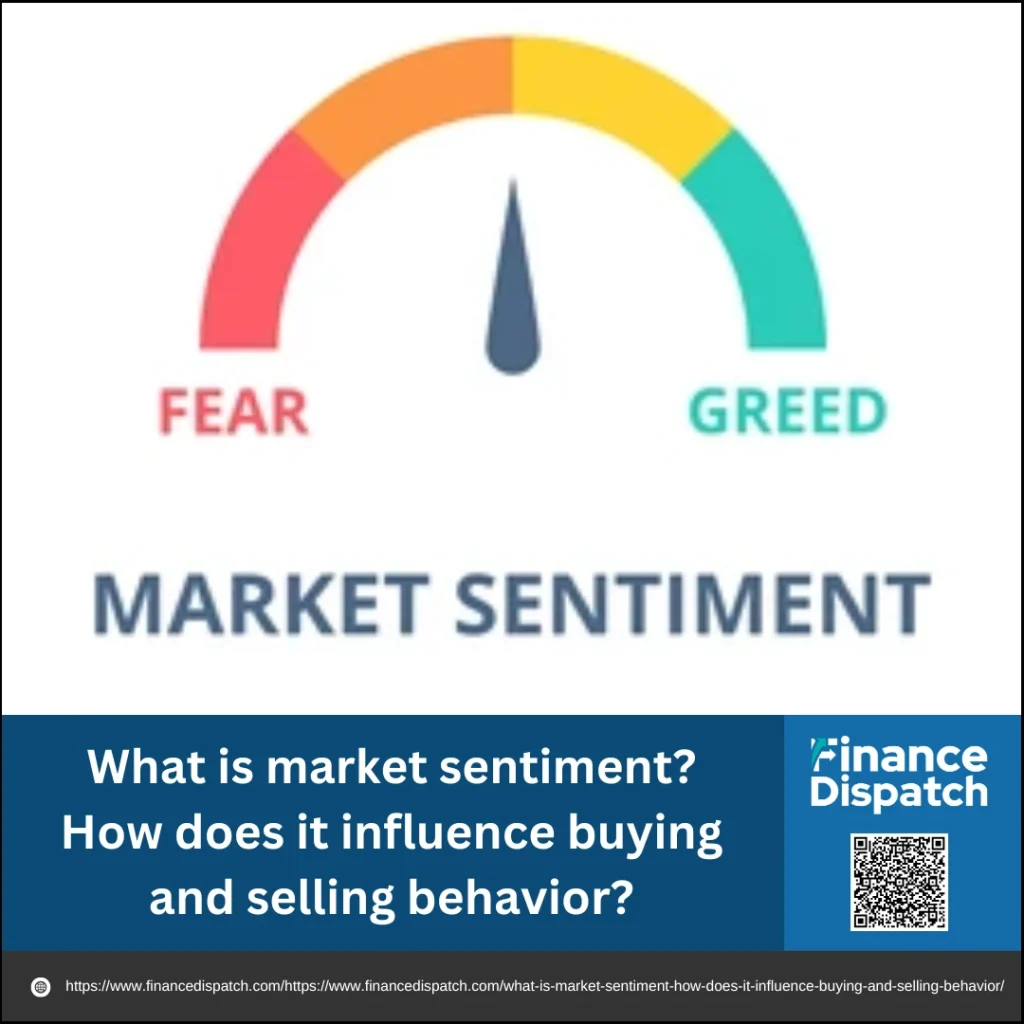In the world of investing and trading, numbers and charts only tell part of the story. The emotions, expectations, and collective psychology of investors—known as market sentiment—play a powerful role in shaping price movements. Whether markets are rising on waves of optimism or falling under clouds of fear, understanding market sentiment can offer critical insights into why buying and selling decisions happen the way they do. In this article, we’ll explore what market sentiment truly means and how it influences the behaviors that drive financial markets.
What is Market Sentiment?
Market sentiment refers to the overall mood, attitude, or feeling that investors collectively hold toward a particular asset, sector, or the financial market as a whole. It reflects whether investors are feeling optimistic (bullish) or pessimistic (bearish) about future price movements. Unlike fundamental analysis, which focuses on a company’s actual performance, market sentiment is more about perception, emotions, and crowd behavior. It often drives short-term price swings, regardless of the underlying financial data, making it a crucial factor for traders, technical analysts, and even long-term investors to understand.
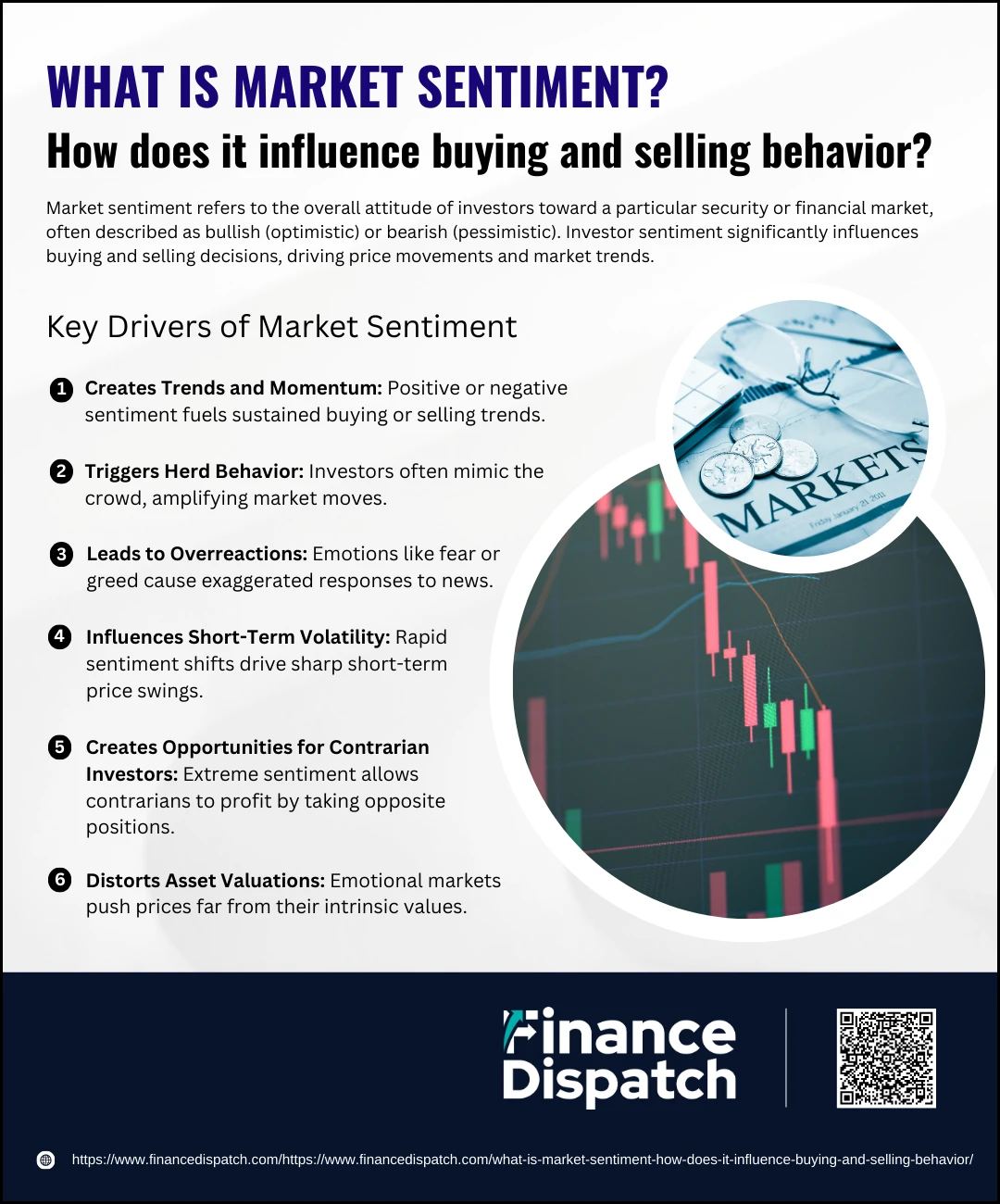 Key Drivers of Market Sentiment
Key Drivers of Market Sentiment
Market sentiment does not form randomly; it is shaped by a combination of economic, political, and psychological factors. Understanding these drivers helps investors anticipate shifts in buying and selling behavior before they fully materialize in the markets. Here are some of the key forces that influence market sentiment:
1. Economic Indicators: Reports on inflation, employment, GDP growth, and consumer confidence strongly influence how investors feel about the economy’s future.
2. Corporate Earnings: Positive or negative earnings results and forward guidance from major companies can dramatically shift sentiment toward specific sectors or the broader market.
3. Interest Rates: Central bank policies, especially changes in interest rates, impact borrowing costs, business investments, and overall market confidence.
4. Political Events: Elections, government policies, regulatory changes, and geopolitical tensions can all cause sudden shifts in sentiment.
5. Global Events: Natural disasters, pandemics, or international conflicts can create widespread fear or optimism in markets.
6. Media and News Headlines: The tone and framing of financial news can amplify investor emotions, reinforcing either bullish or bearish behavior.
7. Social Media Influence: Platforms like Reddit, Twitter, and YouTube can rapidly spread opinions and rumors, leading to fast-moving sentiment shifts.
8. Market Trends and Momentum: Rising or falling prices themselves often fuel sentiment, as investors tend to chase trends driven by the fear of missing out or fear of further losses.
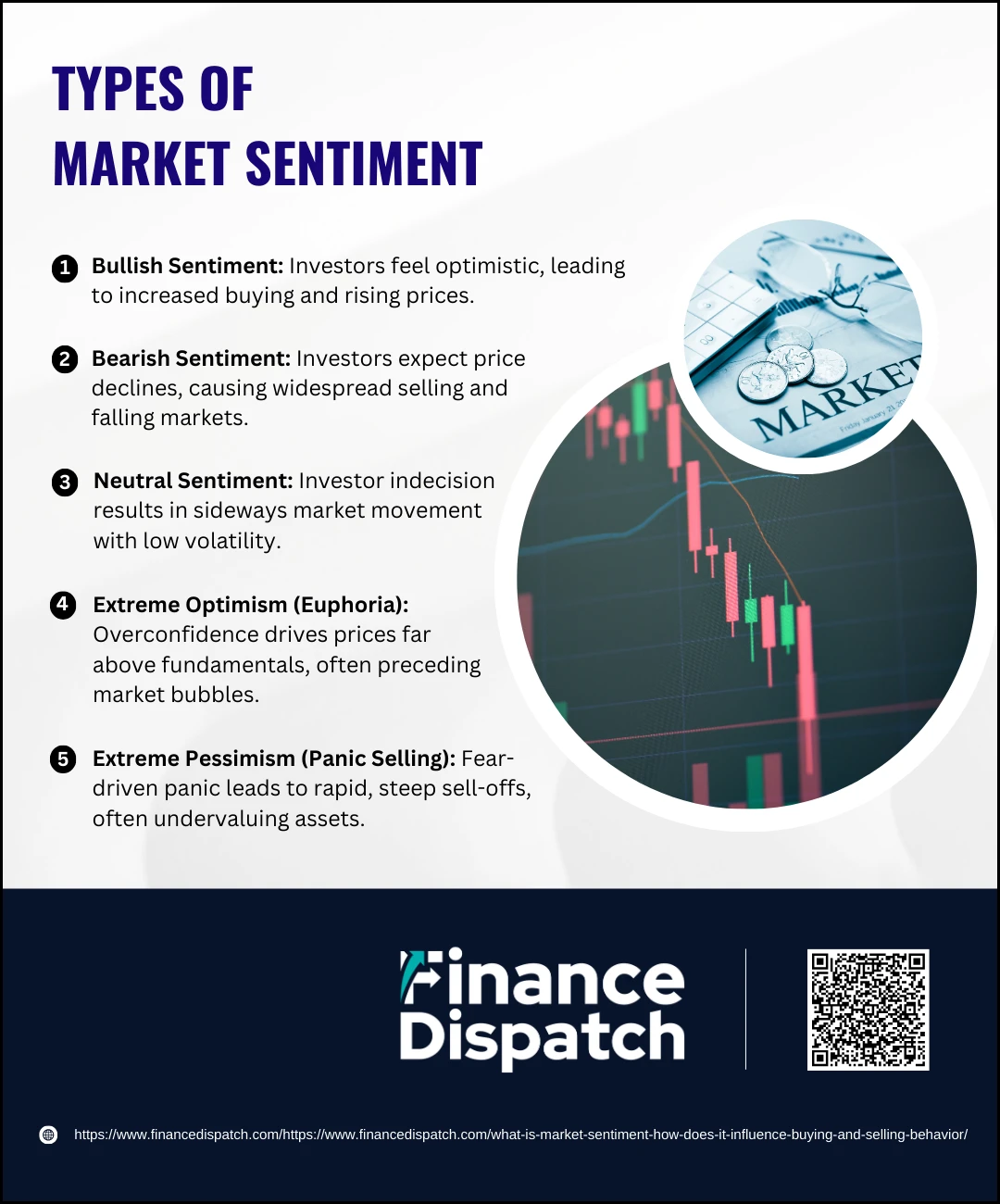 Types of Market Sentiment
Types of Market Sentiment
Market sentiment can generally be categorized based on the collective emotions and expectations of investors. Recognizing different types of sentiment is important because each one can influence market trends, volatility, and trading opportunities in unique ways. Here are the main types of market sentiment you should know:
1. Bullish Sentiment
Bullish sentiment occurs when investors feel confident about the future direction of the market or a specific asset. This optimism leads to increased buying activity, which pushes prices higher over time. A bullish market is often marked by strong economic indicators, positive corporate earnings, and stable political environments. Investors are willing to take on more risk, expecting that asset values will continue to rise.
2. Bearish Sentiment
Bearish sentiment reflects a negative outlook among investors, where fear and caution dominate decisions. In a bearish market, investors expect prices to fall, leading to widespread selling and declining asset values. This sentiment is often triggered by economic downturns, rising unemployment, geopolitical instability, or poor corporate earnings. Bearish phases can last for weeks, months, or even years, depending on the severity of the underlying causes.
3. Neutral Sentiment
Neutral sentiment exists when investors are indecisive or when market signals are mixed. During these periods, neither bullish nor bearish forces dominate, resulting in range-bound trading where prices move sideways. Neutral sentiment typically arises in times of market consolidation, when participants are waiting for clearer economic data, major policy announcements, or corporate earnings results. Trading volumes often decline, and volatility tends to be lower compared to bullish or bearish phases.
4. Extreme Optimism (Euphoria)
Extreme optimism, or market euphoria, happens when investors become excessively confident, believing that prices will continue to rise indefinitely. This sentiment can cause prices to soar far above their fundamental values, forming financial bubbles. Warning signs of euphoria include skyrocketing valuations, speculative buying frenzies, and widespread media hype. Although it feels positive, this sentiment often precedes sharp corrections or sudden market crashes once reality catches up with overblown expectations.
5. Extreme Pessimism (Panic Selling)
Extreme pessimism arises during periods of crisis, when fear overtakes rational thinking. Investors rush to sell assets, often at steep losses, to protect their remaining capital. Panic selling can lead to sharp, rapid declines in market prices, sometimes pushing them well below intrinsic value. Events such as financial collapses, pandemics, or unexpected geopolitical conflicts typically trigger such reactions. While devastating in the short term, extreme pessimism can also create rare buying opportunities for long-term investors who stay calm and objective.
How Market Sentiment Influences Buying and Selling Behavior
Market sentiment plays a crucial role in driving investor behavior, often influencing decisions more powerfully than fundamental analysis. Whether optimistic or fearful, collective emotions can create momentum that fuels buying sprees or selling waves. Understanding how sentiment translates into actual trading actions helps investors better navigate market trends and avoid emotional pitfalls. Here are the key ways market sentiment influences buying and selling behavior:
1. Creates Trends and Momentum
Positive sentiment encourages widespread buying, pushing prices higher and creating upward trends. Similarly, negative sentiment triggers mass selling, leading to downward price momentum. These trends often feed on themselves, reinforcing the existing sentiment.
2. Triggers Herd Behavior
When investors observe the majority buying or selling, they often follow the crowd out of fear of missing out (FOMO) or fear of loss. This herd behavior can amplify market movements far beyond what fundamentals would suggest.
3. Leads to Overreactions
Strong emotions like fear or greed can cause exaggerated reactions to news, earnings reports, or economic data. Investors may overbuy during optimistic periods or oversell during panics, leading to market inefficiencies.
4. Influences Short-Term Volatility
Sudden shifts in sentiment, driven by breaking news or unexpected events, can cause sharp short-term price fluctuations. Traders often try to capitalize on this volatility, but it also increases risks.
5. Creates Opportunities for Contrarian Investors
When sentiment reaches extreme bullishness or bearishness, contrarian investors often step in to take the opposite position. They buy undervalued assets during widespread fear or sell overpriced assets during irrational exuberance.
7. Distorts Asset Valuations
In highly emotional markets, prices can diverge significantly from intrinsic values. Overconfidence can inflate bubbles, while excessive pessimism can drive prices below their true worth, offering opportunities for value investors.
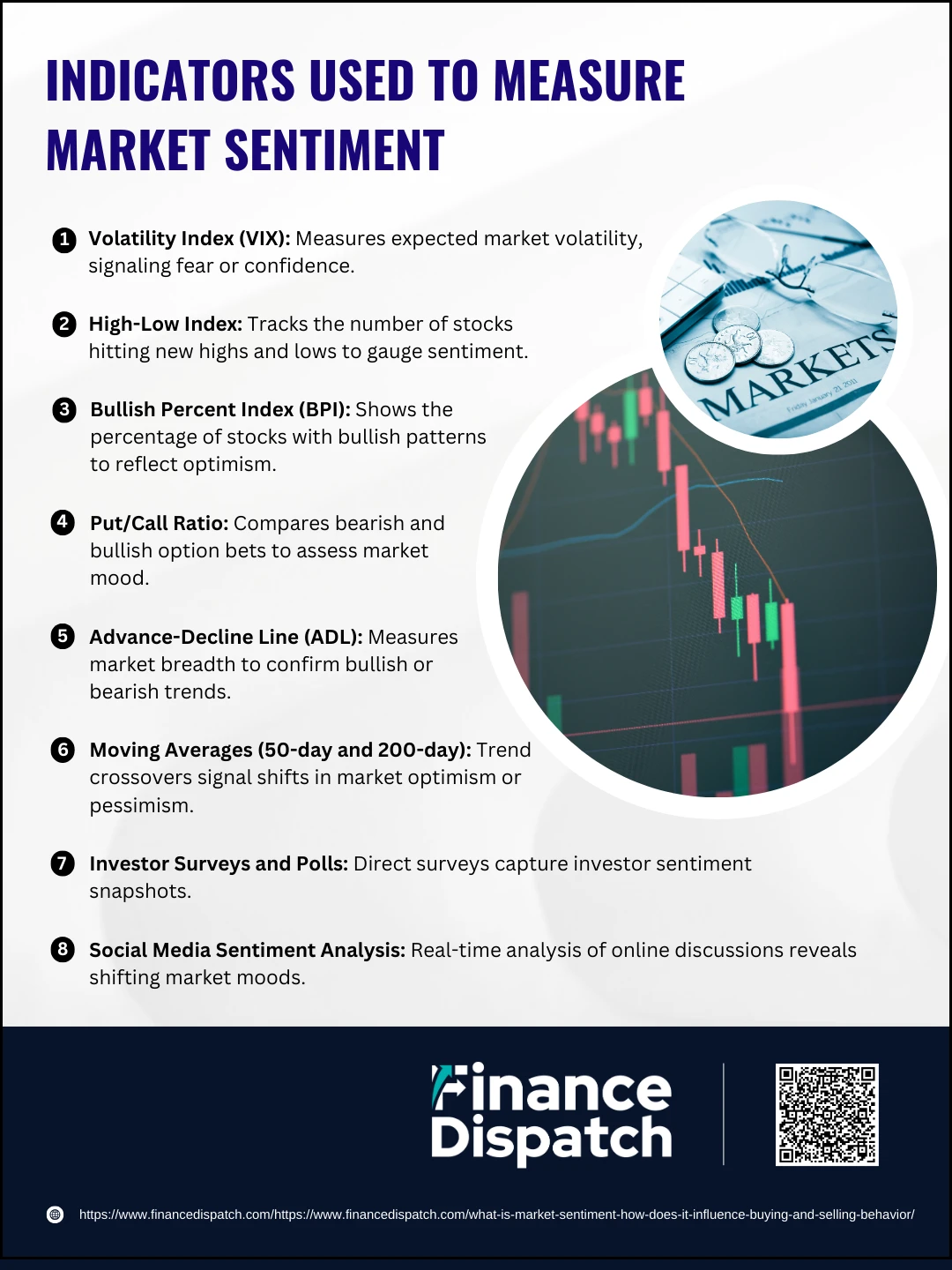 Indicators Used to Measure Market Sentiment
Indicators Used to Measure Market Sentiment
Measuring market sentiment helps investors and traders understand the collective mood driving market movements. While sentiment is emotional and intangible, several technical tools and indicators have been developed to gauge it more precisely. These indicators offer valuable insights into whether the market is leaning bullish, bearish, or sitting in a neutral zone. Here are some of the most widely used indicators to measure market sentiment:
1. Volatility Index (VIX)
Often referred to as the “fear index,” the VIX measures the market’s expectations of volatility over the next 30 days. A high VIX indicates heightened fear and uncertainty, while a low VIX suggests investor confidence and stability.
2. High-Low Index
This indicator compares the number of stocks reaching new 52-week highs to those hitting 52-week lows. A reading above 70 indicates strong bullish sentiment, while below 30 signals strong bearish sentiment.
3. Bullish Percent Index (BPI)
The BPI tracks the percentage of stocks with bullish chart patterns. A high BPI indicates widespread optimism, whereas a low BPI reflects prevailing pessimism in the market.
4. Put/Call Ratio
By comparing the volume of put options (bets on price declines) to call options (bets on price increases), the put/call ratio helps detect investor expectations. A high ratio points to bearish sentiment, while a low ratio signals bullishness.
5. Advance-Decline Line (ADL)
The ADL measures the number of advancing stocks against declining stocks. A rising line suggests positive market breadth and bullish sentiment, whereas a falling line indicates increasing bearishness.
6. Moving Averages (50-day and 200-day)
Moving averages smooth out price trends and are key sentiment indicators. A bullish crossover, where the 50-day average moves above the 200-day average (the “golden cross”), suggests optimism; the reverse (“death cross”) indicates pessimism.
7. Investor Surveys and Polls
Surveys like the AAII Investor Sentiment Survey collect opinions directly from investors, providing a snapshot of whether the majority feel bullish, bearish, or neutral at a given time.
8. Social Media Sentiment Analysis
Algorithms now track keywords, hashtags, and discussions across platforms like Twitter and Reddit. These real-time analyses can detect shifts in public sentiment before they show up in traditional media or market prices.
Real-World Examples of Market Sentiment in Action
Market sentiment is not just a theory — it plays out in dramatic ways across real-world financial markets. Emotions like fear, greed, optimism, and panic often drive price movements beyond what traditional analysis would predict. By studying real examples where sentiment shaped buying and selling behavior, investors can better understand how powerful this invisible force truly is. Here are some notable instances where market sentiment had a significant impact:
1. COVID-19 Market Crash (2020): Fear of a global economic collapse triggered a sharp sell-off across stock markets worldwide, with the S&P 500 dropping over 30% in just a few weeks.
2. Dot-Com Bubble (Late 1990s–2000): Euphoria about internet companies caused tech stock valuations to skyrocket beyond reasonable fundamentals, eventually leading to a massive market crash.
3. GameStop Short Squeeze (2021): Social media-driven optimism and collective action by retail investors on Reddit’s WallStreetBets forum pushed GameStop’s stock price from around $20 to nearly $500 within weeks.
4. Great Financial Crisis (2008): Widespread panic over collapsing financial institutions led to extreme bearish sentiment, massive sell-offs, and the worst economic downturn since the Great Depression.
5. Post-Pandemic Rally (2020–2021): Optimism fueled by stimulus packages, vaccine rollouts, and reopening economies caused stock markets to soar, with tech stocks reaching record highs.
6. Bitcoin Bull Run (2017 and 2020): Growing mainstream acceptance and media hype drove extreme bullish sentiment around cryptocurrencies, leading to explosive price rallies and volatile corrections.
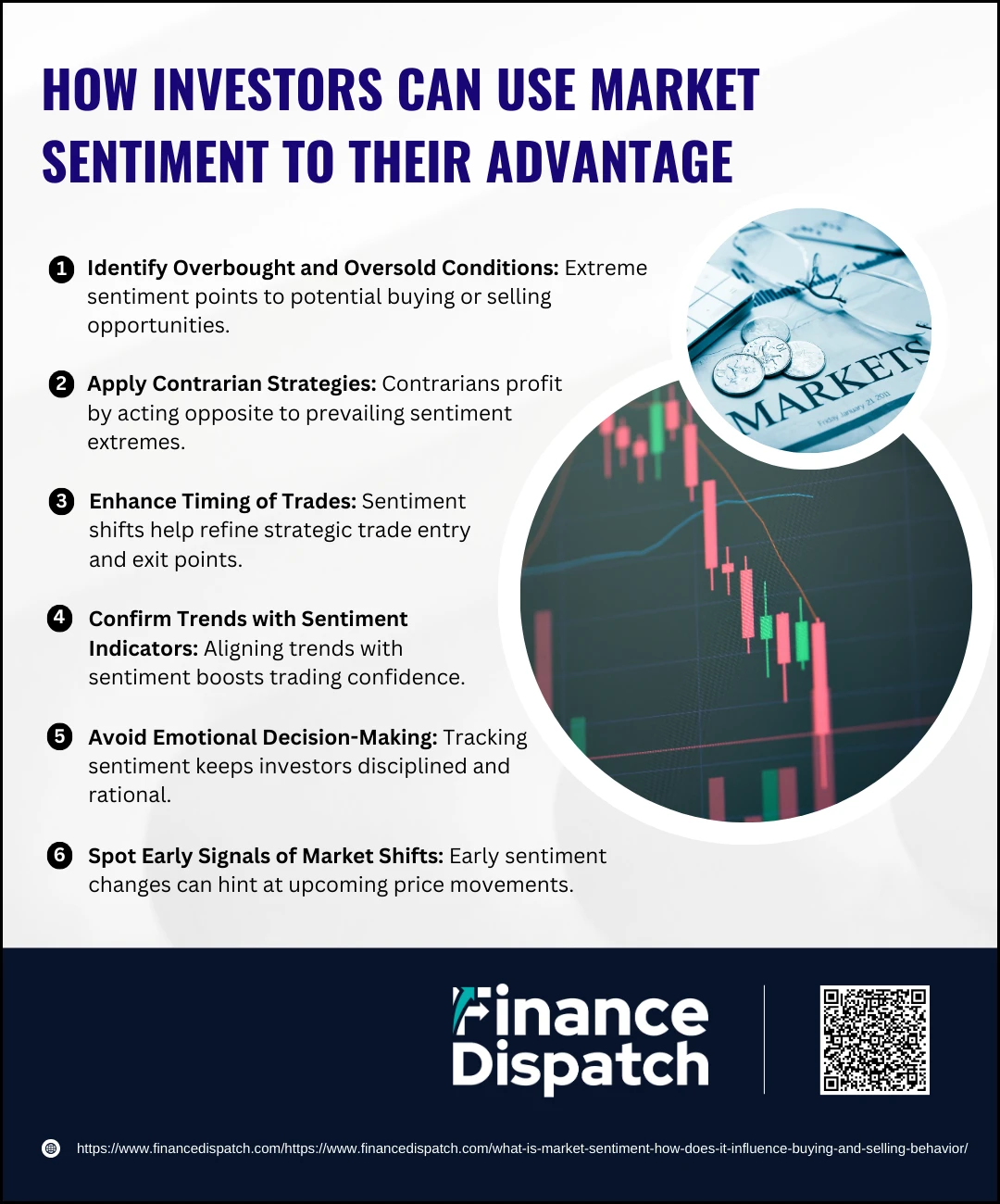 How Investors Can Use Market Sentiment to Their Advantage
How Investors Can Use Market Sentiment to Their Advantage
While market sentiment can cause emotional reactions that drive volatility, savvy investors can use it as a tool rather than a trap. By carefully observing shifts in sentiment, investors can identify opportunities, avoid common mistakes, and make more informed decisions. Rather than getting swept up by the crowd, understanding sentiment trends allows investors to act strategically. Here are key ways investors can use market sentiment to their advantage:
1. Identify Overbought and Oversold Conditions
Extreme bullish or bearish sentiment often signals that prices are stretched too far. Investors can look for these extremes to time entries or exits, buying undervalued assets during fear and selling overvalued ones during euphoria.
2. Apply Contrarian Strategies
When sentiment is overwhelmingly positive or negative, it may indicate an impending market reversal. Contrarian investors use sentiment indicators to move against the crowd, often finding value where others see only risk.
3. Enhance Timing of Trades
Sentiment analysis, combined with technical indicators, can help investors fine-tune the timing of their trades. Watching sentiment shifts around earnings reports, economic announcements, or geopolitical events offers strategic entry and exit points.
4. Confirm Trends with Sentiment Indicators
Positive sentiment supporting an uptrend or negative sentiment reinforcing a downtrend can strengthen confidence in a trading decision. Investors often use tools like the VIX, Put/Call Ratio, and Advance-Decline Line to validate market moves.
5. Avoid Emotional Decision-Making
By objectively tracking sentiment, investors can stay disciplined and avoid emotional reactions like panic selling or greedy buying. Sentiment data acts as a reality check against impulsive moves.
6. Spot Early Signals of Market Shifts
Changes in sentiment often precede changes in price. Monitoring sentiment trends — especially on social media, news outlets, and investor surveys — can alert investors to potential opportunities before the broader market reacts.
Conclusion
Market sentiment is a powerful force that influences buying and selling behavior in ways that go beyond logic and fundamentals. By understanding how emotions shape market movements, investors can better navigate volatility, identify opportunities, and protect themselves from costly mistakes. While sentiment alone should not drive investment decisions, using it alongside technical and fundamental analysis can provide a more complete picture of market dynamics. Staying aware of the crowd’s mood—without blindly following it—can turn market sentiment from a risk into a valuable tool for smarter investing.



